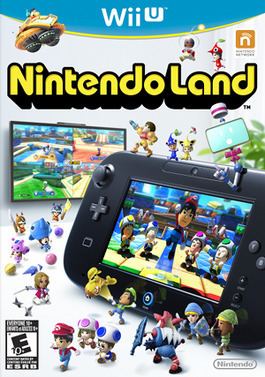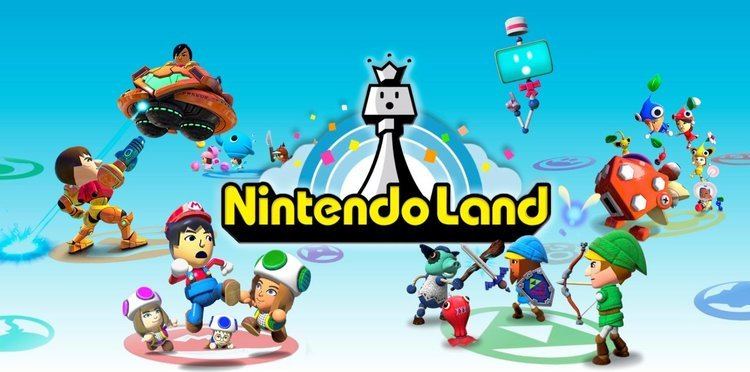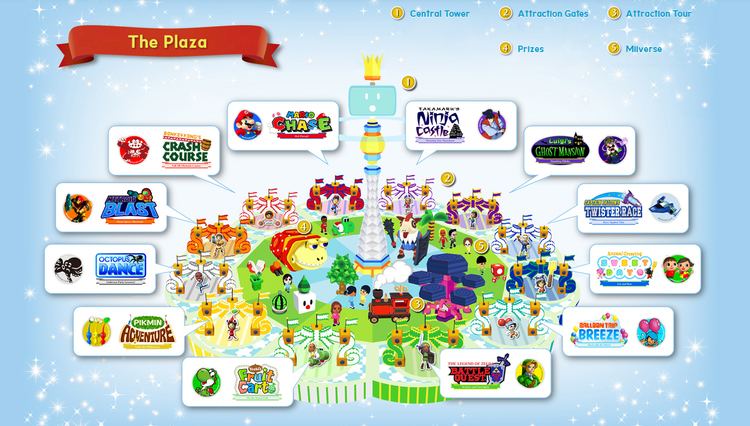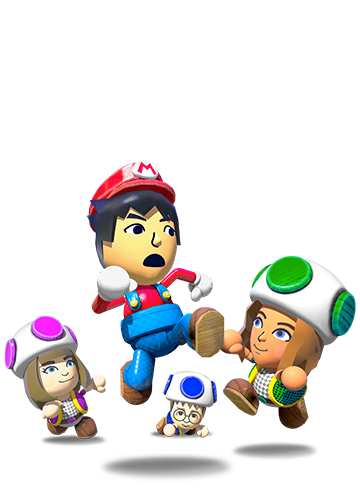9.1 /10 2 Votes
8/10 GameSpot Artist(s) Tsubasa Sakaguchi Initial release date 18 November 2012 | 8.7/10 IGN 77% Metacritic Composer(s) Ryo Nagamatsu Genre Party game | |||||||||||||||||||||||||||||||||
 | ||||||||||||||||||||||||||||||||||
Director(s) Takayuki ShimamuraYoshikazu Yamashita Mode(s) Single-player, multiplayer Similar Nintendo games, Party games, Other games | ||||||||||||||||||||||||||||||||||
Nintendo land part 3 luigi s ghost mansion
Nintendo Land (ニンテンドーランド, Nintendō Rando) is a 2012 party video game developed and published by Nintendo as a pack-in launch title for the Wii U video game console. The game was first announced at E3 2012 during Nintendo's press conference.
Contents
- Nintendo land part 3 luigi s ghost mansion
- Wii u nintendo land trailer
- Gameplay
- Team attractions
- Competitive attractions
- Solo attractions
- Reception
- References
Nintendo Land features twelve different minigames, each based on an existing Nintendo game franchise such as Mario and The Legend of Zelda, depicted as attractions in the eponymous fictional amusement park. The minigames are designed to demonstrate the concept of Wii U and its Wii U GamePad controller to new players, in the same way the 2006 game Wii Sports demonstrated the Wii and its Wii Remote, utilizing many of the controller's features, including its touchscreen controls and motion-sensing capabilities. Some minigames incorporate the Wii Remote Plus and Nunchuk controllers for alternate control schemes and multiplayer support, which also helps exhibit "asymmetric gameplay", a concept in which certain players have different experiences based on the controller they use.

Nintendo Land was mostly liked by critics, and sold five million copies, making it the third highest-selling Wii U game. The ability to download the game was removed from the Nintendo eShop in North America on November 10, 2013., then returned for download on August 26, 2016.

Wii u nintendo land trailer
Gameplay

The game takes place in an amusement park setting, which serves as a hub for the twelve minigames, which are depicted as the park's attractions. A robotic creature named Monita guides the player through Nintendo Land's features and attractions. The twelve minigames of Nintendo Land are based on popular Nintendo franchises (two of the attractions (Metroid Blast and Mario Chase) are based on Wii U tech demos shown at E3 2011, but are modified to feature Nintendo characters) and are designed to incorporate elements which utilize the features of the Wii U GamePad, often in conjunction with other players using Wii Remotes and Nunchucks (with some games supporting up to five players in this configuration). The combination of Wii Remotes and Wii U GamePads allows for what Nintendo calls "asymmetric gameplay," where players have different experiences depending on which controller scheme they use. Completing minigames and completing certain objectives earns coins, which can be used to play a single-player pachinko minigame. Winning pachinko stages will earn new items for decorating the Nintendo Land hub area.
Team attractions
Number of players: 1–5

Based upon The Legend of Zelda series. Up to three players (In red, blue, and yellow) use their swords to fight AI enemies. One more player uses their GamePad (in green) to control a character in the rear of the pack using a bow and arrow. The player with the GamePad can also lift their controller to spy for sniping AI. To reload their bow and arrow, the player aims the GamePad down.

Based upon the Metroid series and the "Battle Mii" tech demo from E3 2011. The player using the Wii U GamePad controls Samus' Gunship, while up to four players with Wii Remotes and Nunchuks control Mii characters on foot, wearing Varia Suits. There are three modes, "Assault Mission", "Surface-Air Combat", and "Ground Battle". In "Assault Mission", the players cooperate to defeat waves of enemies and complete missions. In "Surface-Air Combat", the players with Wii Remotes and Nunchuks try to shoot down the player with the GamePad. In "Ground Battle" all players use Wii Remotes and Nunchuks in a battle for tokens.
Based on the Pikmin series. One player controls Captain Olimar who can command tiny Pikmin using the Wii U GamePad, whilst four additional players (As red, blue, yellow and white Pikmin) can control larger Pikmin using the Wii Remotes. Players must work together to help navigate levels and defeat enemies, including a boss at the end of the stage. When the boss is defeated, the players board Olimar's ship. There is also a Versus Mode where the players compete for candy.
Competitive attractions
Number of players: 2–5
Mario Chase, inspired by the Super Mario series, is a tag-based game that takes place inside an arena consisting of large obstacles, hills, and slides. Four players, whose Mii characters are dressed in Toad costumes, pursue and attempt to catch the fifth player, whose Mii is dressed as Mario. The Mario player, who views the action on the Wii U GamePad screen from a top-down perspective, has a map of the entire arena and can see the location of all the Toad players. The Toad players view the action on the television in split-screen from a third person perspective, and are each only given his current distance from Mario in yards or meters (depending on the region). The Toad players win if one of them catches Mario before the time limit expires, otherwise the Mario player will win. If there are less than three players, the remaining Toad characters may be replaced by computer-controlled Yoshi robots.
Luigi's Ghost Mansion, inspired by the 2001 Nintendo GameCube launch title Luigi's Mansion and based on the 2003 game Pac-Man Vs., is a game in which up to four players (dressed like Mario, Luigi, Wario and Waluigi) assume the roles of "ghost trackers" and explore a haunted house to hunt for the fifth player, who is the ghost. Each level is set on a different floor with different layouts of rooms and hallways, and the action is viewed from above, showing the entire floor and the location of all players. The trackers must find the ghost player, who remains invisible on the television screen, and decrease its health (a numerical value from 0 to 100) by shining their flashlights upon it. Meanwhile, the ghost must sneak up and ambush each tracker to make him faint. The ghost's proximity to a tracker is made known when that player's Wii Remote begins to vibrate, and different events or conditions may cause the ghost to temporarily become visible to all trackers. Fainted trackers can be revived by the others by using their flashlights, though flashlight energy is in limited reserve and must be restored by picking up battery items. The ghost wins if all the trackers have fainted; the trackers win if they decrease the ghost's health to zero.
Based on the Animal Crossing series, four players control animals trying to collect candy as a team before they get caught 3 times by the guards, controlled by another player using the GamePad. As players collect more candies, their movement becomes slower, making it easier for them to be caught. If playing with only two players, the format changes to the stash rules, where one animal must collect candies and must put fifteen into the stashes on the map.
Solo attractions
Number of players: 1
Based on the 1986 Family Computer Disk System game Nazo no Murasame Jō, the player uses the GamePad's touchscreen to launch paper shuriken at waves of enemy ninjas. The controller can be tilted in order to change the trajectory of the throws. On boss ninjas or ninjas who are at close range, the players uses a katana.
The player uses the GamePad to tilt a trolley through a platform-based obstacle course, influenced by the original Donkey Kong arcade game. The analog sticks and L and R shoulder buttons can be manipulated to activate various levers, elevators, and pathways to advance the player throughout the course.
A single-player game based on Nintendo's futuristic racing game F-Zero, where the player must race down a track while avoiding obstacles in 12 different areas. The GamePad is held vertically and the gyroscope is used to steer the vehicle. The GamePad provides an aerial view (a more strategical view) of the track while the TV provides a third-person view on the track.
In this single-player game, based on Nintendo's Balloon Fight, the player will control their Mii on a play-field similar to the Balloon Trip mode. The player does this by swiping the stylus on the GamePad's touch screen to create gusts of wind that will move the Mii around. The GamePad will offer a zoomed-in view whereas the TV will offer a zoomed-out view. The levels are divided into morning, afternoon, evening and night, which are all ended by landing on an island. Occasionally, there are packages on islands that the player can pick up to protect and deliver to the next island.
This attraction is based on the Yoshi series. The player has to guide Yoshi to the finish by collecting all the fruit in the level, by making a trail on the GamePad using the stylus. The fruit is only visible on the TV screen, so the player must use reference points in the background to draw the path on the GamePad.
This attraction is based on Game & Watch Octopus. Octopus Dance is a rhythm game which plays by using the GamePad's Control Sticks and Gyro Sensor. Players must memorize and replicate the actions performed by the diver on screen.
Reception
The game has received positive reviews from video games critics, praising its party atmosphere and attractions, especially the way they are developed and built up, with a few being critical of simply showing Wii U GamePad capabilities. IGN praised the game for showing the Wii U capabilities, its gameplay, its detailed and HD graphics and claiming that "Wii Sports has met its match", giving it an 8.7 score.
By March 2014, the game had sold 3.09 million copies, and by December 2014, it had sold 4.44 million units worldwide. As of December 31, 2016, the game has sold 5.16 million copies.
